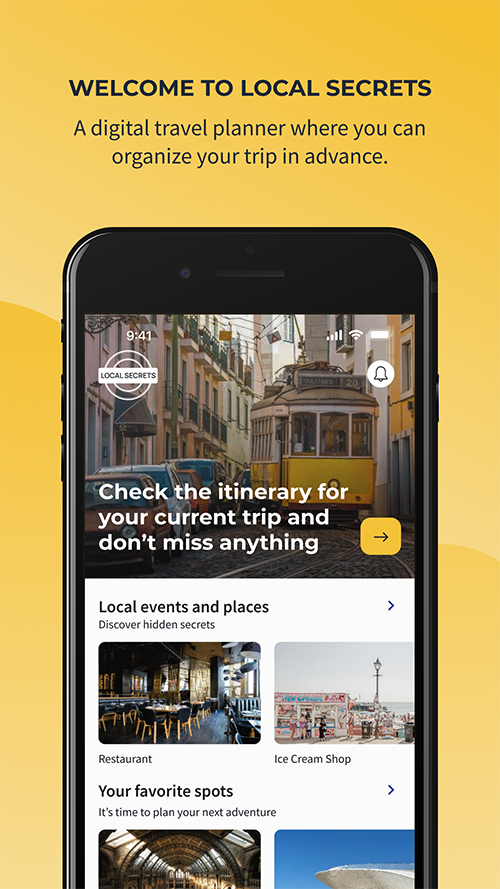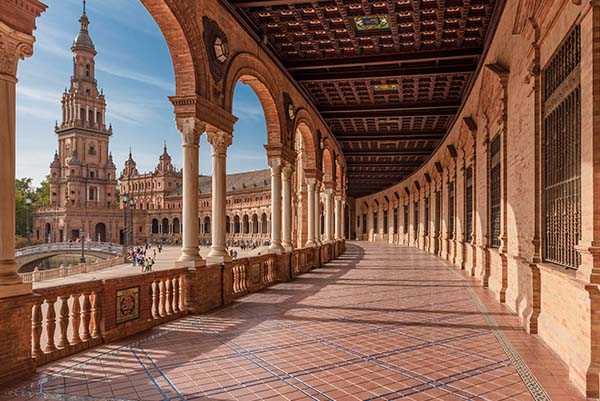
Exploring Seville: A Journey Through the Heart of Andalusia
Seville, the capital of Andalusia in southern Spain, is a city steeped in history, culture, and charm. Known for its rich Moorish and Christian heritage, vibrant festivals, and iconic landmarks, Seville is a must-visit destination for travelers seeking a blend of tradition and modernity. In this article, we will explore Seville’s location, the best time to visit, its most notable historical attractions, recommended activities, unique accommodations, and dining areas that offer a taste of local life.
Seville is located in the southwest of Spain, nestled along the banks of the Guadalquivir River. It is the capital and largest city of the Andalusian region, known for its vibrant cultural life and historic significance as a former center of Moorish rule. The city lies about 100 kilometers (62 miles) from the Atlantic Ocean, with nearby access to the Sierra Norte mountain range. Seville’s location has historically made it an important crossroads for trade and culture, particularly during the Spanish Golden Age when it served as the gateway to the Americas. Today, its strategic position makes it a natural starting point for exploring the rest of Andalusia.
Best Time to Visit: Seville’s Year-Round Appeal
The best time to visit Seville is in the spring (March to May) or autumn (September to November) when the weather is pleasant and mild, with temperatures ranging from 15°C to 25°C (59°F to 77°F). Spring, in particular, is a fantastic time to experience the city’s famous festivals, including Semana Santa (Holy Week) and La Feria de Abril (April Fair). These celebrations are deeply rooted in Seville’s culture and offer visitors a chance to witness spectacular processions, traditional costumes, and lively Andalusian dancing.
Summers in Seville can be extremely hot, with temperatures frequently exceeding 40°C (104°F), making it less comfortable for sightseeing. However, if you visit during this time, you can take advantage of the slower pace and quieter streets, as many locals leave the city for the coast.
Winter is mild, with temperatures rarely dropping below 10°C (50°F), making it an ideal season for those looking to explore Seville’s historical sites without the heat or crowds.
Things to See: Five Historical Attractions in Seville
- The Alcázar of Seville
The Alcázar of Seville is one of the oldest royal palaces still in use in Europe and a UNESCO World Heritage Site. Originally built as a Moorish fort in the 10th century, the palace is a stunning example of Mudéjar architecture, blending Islamic, Gothic, Renaissance, and Baroque elements. The intricate tilework, serene courtyards, and lush gardens make it a must-see for visitors. Its rooms and halls tell the story of Seville’s Moorish past and its later transformation into a Christian stronghold. - Seville Cathedral and La Giralda
Seville Cathedral, the largest Gothic cathedral in the world, is a monumental testament to the city’s Christian heritage. Completed in the early 16th century on the site of a former mosque, it is home to the tomb of Christopher Columbus. Adjacent to the cathedral stands La Giralda, a former minaret converted into a bell tower, offering spectacular views of the city. Climbing to the top of La Giralda provides insight into Seville’s unique fusion of Moorish and Christian architecture. - Plaza de España
Built for the 1929 Ibero-American Exposition, Plaza de España is an architectural masterpiece that blends Renaissance Revival and Moorish Revival styles. The semi-circular plaza is framed by grand buildings and a large central fountain. Its ceramic-tiled alcoves represent Spain’s provinces, making it a vibrant and picturesque spot for photos. A walk along the canal or a boat ride offers a peaceful escape in one of Seville’s most iconic public spaces. - Santa Cruz Quarter
The Santa Cruz Quarter, Seville’s old Jewish district, is a maze of narrow streets, whitewashed houses, and hidden courtyards filled with flowers. This atmospheric neighborhood is perfect for wandering and discovering small tapas bars, artisan shops, and historic sites like the Church of Santa María la Blanca. It’s a journey back to Seville’s medieval past, offering glimpses of Moorish influence and Christian reconquest. - Metropol Parasol
A modern architectural wonder, Metropol Parasol, also known as “Las Setas” (The Mushrooms), is the largest wooden structure in the world. Designed by architect Jürgen Mayer, this unique urban landmark offers panoramic views of Seville from its top-level walkway. Beneath the parasol, you can explore an archaeological museum and a lively market, blending contemporary design with the city’s historic layers.
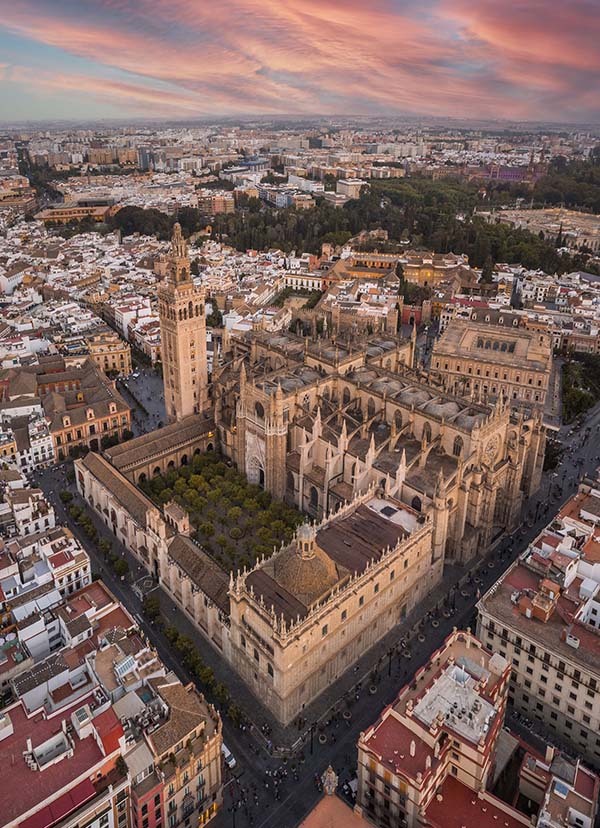
Aerial view of the Sevilla Cathedral
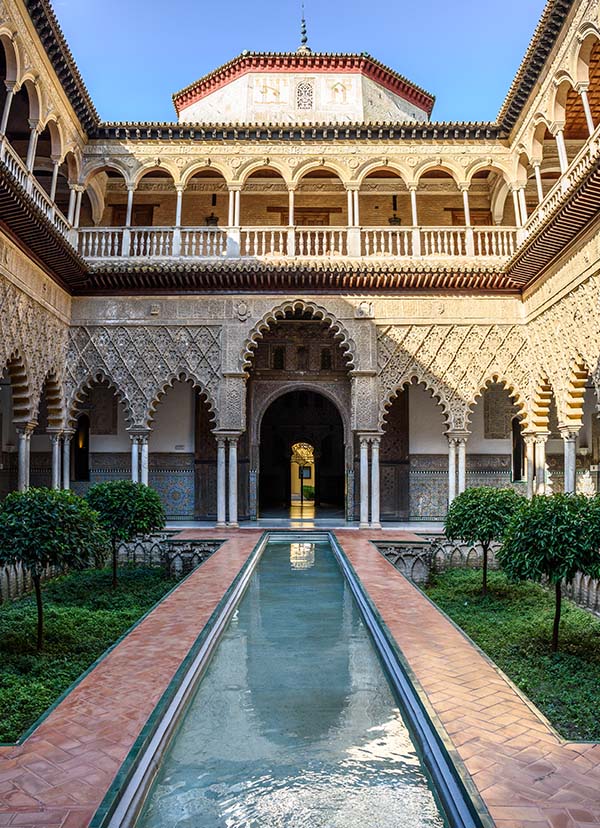
Patio de las Doncellas, Seville
Recommended Activities: Five Varied Experiences in Seville
- Experience Flamenco at a Tablao
Flamenco is an essential part of Seville’s cultural identity, and no visit is complete without witnessing a live performance. Head to one of the city’s renowned tablaos, such as El Arenal or Los Gallos, for an evening of passionate music, singing, and dance. Flamenco’s roots run deep in Andalusia, and watching the artists perform with such intensity is a truly moving experience. - Take a River Cruise on the Guadalquivir
For a more relaxed experience, take a cruise along the Guadalquivir River. This scenic waterway offers a unique perspective of Seville’s landmarks, including the Torre del Oro and the city’s bridges. Couples can enjoy the tranquility of the river while learning about the city’s historical importance as a port. - Visit the Museum of Fine Arts
The Museum of Fine Arts (Museo de Bellas Artes) in Seville houses an impressive collection of Spanish art from the medieval period to the 20th century. The museum is particularly noted for its works by Spanish Golden Age artists, including Bartolomé Esteban Murillo, Diego Velázquez, and Francisco de Zurbarán. It’s a cultural experience that art lovers won’t want to miss. - Explore the María Luisa Park
Adjacent to Plaza de España, María Luisa Park is a lush, expansive green space perfect for a leisurely afternoon walk. The park’s romantic atmosphere, with its fountains, shaded paths, and Moorish-inspired pavilions, provides a peaceful retreat from the busy city. You can rent a bike or a horse-drawn carriage to explore the grounds or relax by the park’s picturesque ponds. - Indulge in a Tapas Tour
Seville is famous for its tapas culture, and a guided tapas tour is a great way to experience the city’s culinary delights. Visit local tapas bars in neighborhoods like Triana or Alameda de Hércules and sample dishes such as jamón ibérico, tortilla española, and gambas al ajillo (garlic shrimp). Pair your tapas with a glass of Andalusian sherry for a truly authentic experience.
Where to Stay
- Hotel Alfonso XIII
For a luxurious stay, Hotel Alfonso XIII is one of Seville’s most iconic accommodations. Built in 1928, this five-star hotel combines Moorish, Renaissance, and Castilian styles, offering a grand and elegant experience. It is located near the Alcázar and offers stunning interiors, a beautiful courtyard, and a world-class restaurant. - Corral del Rey
Corral del Rey is a boutique hotel located in the historic heart of Seville, just a short walk from the cathedral. Housed in a restored 17th-century palace, this hotel offers a blend of modern comfort and traditional Andalusian architecture. Its intimate atmosphere and stylish design make it an ideal choice for couples. - Boutique Hotel Casa del Poeta
Tucked away in the Santa Cruz Quarter, Casa del Poeta offers a serene and romantic stay. This small hotel features a charming courtyard with a central fountain and rooms decorated with classic Andalusian touches. Its proximity to Seville’s main attractions makes it a perfect base for exploring the city.
Vacation Rentals
Visit Local Secrets Hospitality Partners
Valcambre (Vacation Rental)
For a more private experience, Valcambre offers beautifully designed vacation rentals in the heart of the city. With modern amenities and close proximity to local markets and restaurants, it’s an excellent choice for travelers seeking a home-like atmosphere.
6. Dining Areas: Exploring Seville’s Culinary Scene
One of the most popular areas for dining among locals is Triana, located just across the river from the historic center. Triana is known for its authentic Andalusian cuisine and lively atmosphere, particularly around Calle Betis and Plaza del Altozano.
Here, visitors can find a wide variety of tapas bars and restaurants offering traditional Spanish dishes at reasonable prices. Popular tapas options include solomillo al whisky (pork loin in whiskey sauce) and espinacas con garbanzos (spinach with chickpeas).
For a truly local experience, pair your meal with a glass of Andalusian sherry or a refreshing tinto de verano.
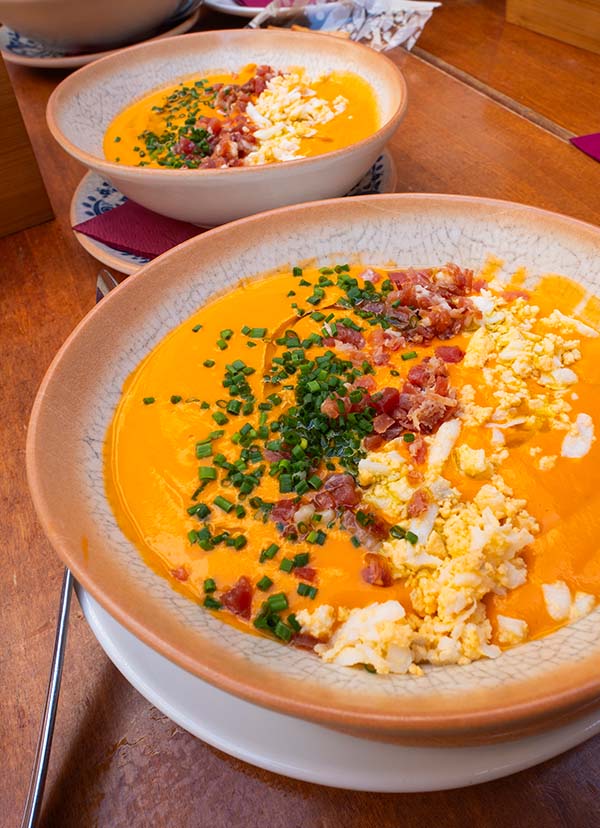
Salmorejo
Why you should Visit
Seville is a city where history, culture, and modern life intertwine seamlessly. With its grand palaces, lively plazas, and intimate flamenco performances, Seville offers a rich and varied experience for every traveler. Whether you’re strolling through the gardens of the Alcázar, dining on tapas in Triana, or exploring its narrow streets, Seville promises to leave an unforgettable mark on your heart.


